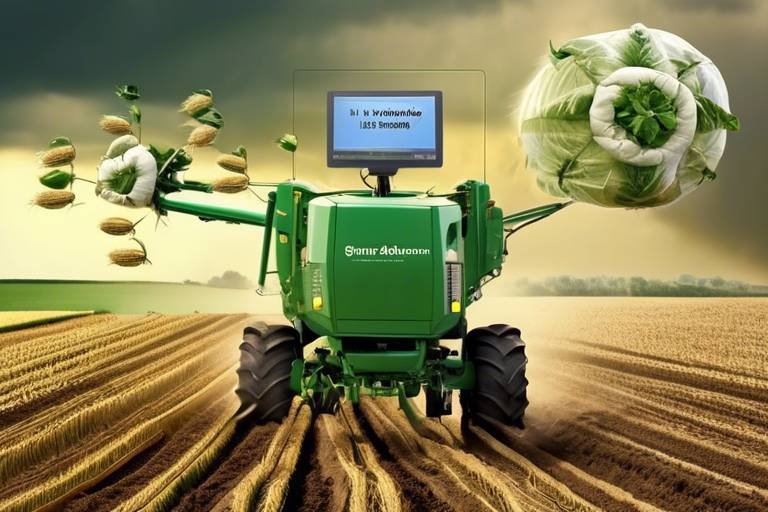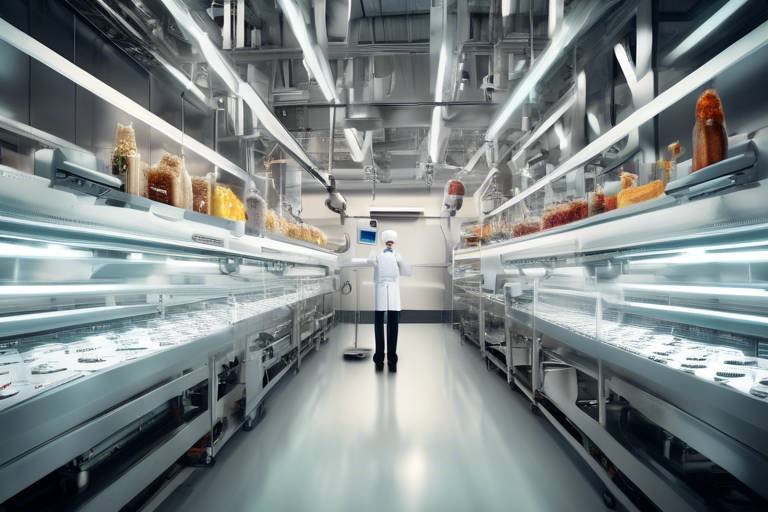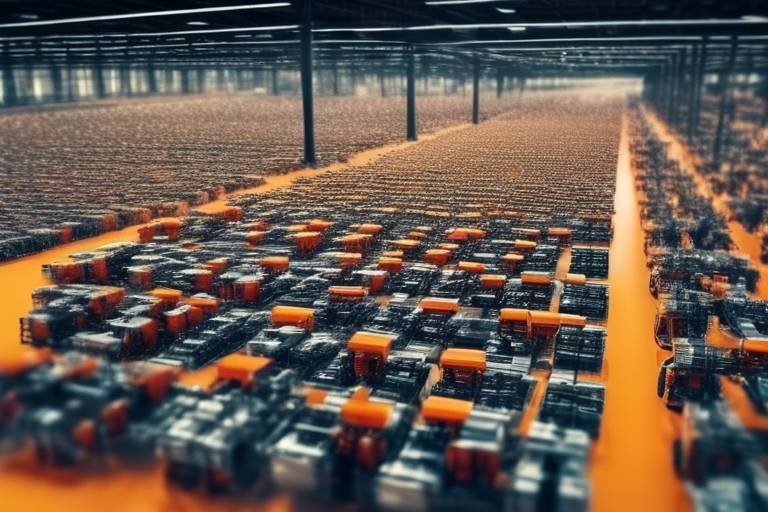Technology in Agriculture: Farming of the Future
In the rapidly evolving world we live in, technology is not just a luxury; it’s a necessity. When it comes to agriculture, the integration of technology is nothing short of revolutionary. Imagine a world where farmers can predict crop yields with pinpoint accuracy, manage resources efficiently, and ensure sustainability—all thanks to innovative technologies. This article explores the transformative role of technology in agriculture, highlighting innovations that enhance productivity, sustainability, and efficiency in modern farming practices.
Precision farming utilizes technology to monitor and manage field variability in crops, allowing farmers to optimize inputs for higher yields and reduced waste. By leveraging data analytics and GPS technology, farmers can apply fertilizers and pesticides only where needed, minimizing environmental impact. This approach not only boosts productivity but also saves costs, making farming more profitable. Think of it as giving each plant exactly what it needs, no more, no less. The result? Healthier crops and a healthier planet.
Water is one of our most precious resources, and smart irrigation systems are here to help us use it wisely. These systems employ sensors and data analytics to deliver water precisely when and where it’s needed. By monitoring soil moisture levels and weather conditions, farmers can ensure that crops receive the right amount of water at the right time, promoting water conservation and improving crop health. It’s like having a personal assistant for your garden, ensuring that every drop counts.
Imagine soaring above your fields, getting a bird’s-eye view of your crops. Drones are revolutionizing agriculture by providing aerial imagery for crop monitoring. With the ability to cover vast areas quickly, drones enable timely interventions, such as identifying pest infestations or nutrient deficiencies before they become major issues. They enhance overall farm management, allowing farmers to make informed decisions based on real-time data. It’s like having a superhero sidekick, always on the lookout for trouble!
When it comes to ensuring food security, genetic engineering techniques, such as CRISPR, are game-changers. These methods are being used to develop crops that are more resilient to diseases and environmental stresses. Imagine crops that can thrive in drought conditions or resist pests without the need for harmful pesticides. This innovation not only boosts food production but also contributes to sustainable farming practices. It’s like giving plants a superpower to withstand the challenges of nature.
Farm management software integrates various agricultural processes, providing farmers with tools for planning, monitoring, and analyzing all activities on their farms. From tracking crop yields to managing labor and finances, this software allows for a holistic view of farm operations. It’s akin to having a control center where every decision is data-driven, ensuring that farmers can maximize efficiency and profitability. With these tools, farmers can focus more on growing and less on guesswork.
Labor-intensive tasks in agriculture, such as planting and harvesting, are being transformed by robotics and automation. These technologies streamline operations, increasing efficiency and reducing reliance on manual labor. Imagine a field where robots plant seeds with precision or harvest crops faster than any human could. This not only saves time but also reduces the physical strain on workers, making agriculture a more attractive career option for future generations.
Vertical farming is an innovative approach that utilizes controlled environments to maximize space and resource use. By growing crops in stacked layers, farmers can produce food in urban areas while minimizing the environmental impact of traditional farming. It’s like turning skyscrapers into farms, where fresh produce is grown right where it’s consumed. This method not only conserves land but also reduces transportation costs and emissions, paving the way for a more sustainable future.
In a world where transparency is key, blockchain technology enhances traceability in the agricultural supply chain. By securely recording every transaction, blockchain ensures food safety and builds consumer trust. Imagine knowing exactly where your food comes from and how it was produced—this technology makes that possible. It’s a game-changer for both producers and consumers, fostering a sense of accountability in the food system.
Lastly, renewable energy solutions, such as solar and wind power, are being adopted in agriculture to reduce carbon footprints and operational costs. By harnessing the power of nature, farmers can decrease their reliance on fossil fuels, promoting sustainable farming practices. Picture a farm where the sun powers irrigation systems and wind turbines generate electricity—this is the future of agriculture, where sustainability and productivity go hand in hand.
- What is precision farming? Precision farming is a modern agricultural practice that uses technology to monitor and manage field variability in crops, optimizing inputs for higher yields.
- How do smart irrigation systems work? Smart irrigation systems use sensors to determine soil moisture levels and weather conditions, delivering water precisely when and where it’s needed.
- What role do drones play in agriculture? Drones provide aerial imagery for crop monitoring, enabling farmers to make timely interventions and enhance farm management.
- What is genetic engineering in agriculture? Genetic engineering involves using advanced techniques to develop crops that are more resilient to diseases and environmental stresses.
- How does farm management software benefit farmers? Farm management software integrates various agricultural processes, allowing farmers to plan, monitor, and analyze all activities efficiently.

Precision Farming
Imagine a world where farmers can see the exact needs of every inch of their fields, almost like having a personal assistant for each crop. This is the essence of , a revolutionary approach that harnesses cutting-edge technology to monitor and manage the variability in crops. By utilizing tools such as GPS, sensors, and data analytics, farmers can optimize their resources and inputs, leading to higher yields and significantly reduced waste.
At its core, precision farming is about understanding the unique characteristics of each plot of land. No two areas are the same, and this is where technology comes into play. By collecting data on soil composition, moisture levels, and crop health, farmers can tailor their practices to meet the specific needs of their crops. This not only enhances productivity but also promotes sustainability, as resources are used more efficiently. For example, instead of applying the same amount of fertilizer across an entire field, farmers can target areas that require more nutrients, thereby minimizing excess runoff into nearby waterways.
To give you a clearer picture, let’s break down some of the key components of precision farming:
- Soil Sensors: These devices provide real-time data on soil conditions, allowing farmers to make informed decisions about irrigation and fertilization.
- GPS Technology: With GPS-guided equipment, farmers can achieve unparalleled accuracy in planting, spraying, and harvesting, reducing overlap and waste.
- Data Analytics: Advanced software analyzes collected data to provide insights and recommendations, making it easier for farmers to adapt their strategies.
Furthermore, the integration of precision farming practices can lead to significant economic benefits. A study conducted by the Food and Agriculture Organization (FAO) showed that farmers who adopted precision agriculture techniques could see a yield increase of up to 20%. This not only boosts their income but also contributes to global food security by ensuring that more food is produced sustainably.
However, the journey towards precision farming isn’t without its challenges. Initial costs for technology and training can be high, particularly for small-scale farmers. Yet, as technology continues to evolve and become more accessible, the barriers to entry are gradually lowering. The future looks bright, with innovations popping up that promise to make precision farming more affordable and user-friendly.
In conclusion, precision farming is not just a trend; it's a necessary evolution in agriculture. As we face the dual challenges of a growing population and environmental sustainability, embracing these technologies will be crucial. Farmers equipped with the right tools can not only enhance their productivity but also play a vital role in protecting our planet for future generations.

Smart Irrigation Systems
In the vast world of agriculture, water is life. Yet, managing this precious resource effectively can be a daunting challenge for farmers. Enter , a groundbreaking innovation that takes the guesswork out of watering crops. By utilizing advanced sensors and data analytics, these systems ensure that water is delivered precisely when and where it’s needed, promoting not only water conservation but also enhancing the health of the crops.
Imagine a farmer standing in a field, equipped with the latest technology that allows them to monitor soil moisture levels in real-time. With smart irrigation systems, this scenario is not just a dream; it's a reality. These systems analyze various factors such as weather forecasts, soil conditions, and even plant health, allowing farmers to make informed decisions about irrigation schedules. The result? A significant reduction in water waste and improved crop yields.
One of the most exciting aspects of smart irrigation is its ability to adapt to changing conditions. For instance, if a sudden rainstorm occurs, the system can automatically adjust and delay watering, preventing over-saturation of the soil. This not only conserves water but also protects crops from root diseases caused by excessive moisture. It's like having a personal assistant for your farm, always ready to optimize your irrigation practices.
Furthermore, smart irrigation systems come equipped with features that can be monitored remotely. Farmers can check on their irrigation status from anywhere, using their smartphones or computers. This level of control and accessibility means that even if a farmer is miles away from their fields, they can still ensure that their crops are receiving the right amount of water at the right time.
To illustrate the benefits of smart irrigation systems, let’s take a look at some key statistics:
| Benefit | Statistic |
|---|---|
| Water Savings | Up to 50% reduction in water usage |
| Increased Crop Yield | Up to 30% increase in crop yield |
| Labor Efficiency | Reduction in labor costs by 20% |
It's clear that smart irrigation systems are not just a trend; they are a necessity in modern agriculture. As we face the challenges of climate change and a growing global population, adopting such technologies becomes imperative. Farmers who embrace smart irrigation are not only ensuring the sustainability of their operations but also contributing to a more resilient food system for the future.
In conclusion, smart irrigation systems represent a transformative leap forward in agricultural practices. By harnessing the power of technology, farmers can optimize their water usage, improve crop health, and ultimately enhance their productivity. As we continue to innovate and adapt, these systems will play a crucial role in shaping the future of farming, making it more efficient, sustainable, and environmentally friendly.
- What are smart irrigation systems?
Smart irrigation systems utilize technology such as sensors and data analytics to manage and optimize water usage in agriculture. - How do smart irrigation systems save water?
These systems deliver water precisely when and where it's needed, preventing overwatering and reducing waste. - Can I monitor my irrigation system remotely?
Yes, many smart irrigation systems allow farmers to monitor and control their irrigation from smartphones or computers. - What are the benefits of using smart irrigation?
Benefits include significant water savings, increased crop yield, and improved labor efficiency.

Drones in Agriculture
Drones are not just the latest gadget for tech enthusiasts; they are revolutionizing the agricultural landscape in ways we never imagined. Imagine being able to monitor your entire farm from the sky, spotting issues before they escalate, and making data-driven decisions that enhance your crop yields. have emerged as a powerful ally for farmers, providing them with the tools they need to tackle the challenges of modern farming.
One of the most significant advantages of using drones is their ability to provide aerial imagery for crop monitoring. Equipped with high-resolution cameras and sensors, these flying devices can capture detailed images of fields, allowing farmers to assess crop health and identify areas that require attention. This is akin to having a bird's-eye view of your farm, enabling timely interventions that can save both time and resources.
Moreover, drones can collect vital data through various sensors, including multispectral and thermal imaging. This data can be processed to create NDVI (Normalized Difference Vegetation Index) maps, which help in understanding plant health and vigor. By analyzing these maps, farmers can make informed decisions about irrigation, fertilization, and pest management. This level of precision is crucial in today's world, where every drop of water and every ounce of fertilizer counts.
Another exciting application of drones is in crop spraying. Traditionally, this task required heavy machinery and a lot of manpower, but drones can efficiently spray pesticides and fertilizers over large areas in a fraction of the time. Not only does this reduce labor costs, but it also minimizes the environmental impact by ensuring that chemicals are applied precisely where they are needed, reducing runoff and waste.
Despite the numerous benefits, the adoption of drone technology in agriculture is not without its challenges. Farmers must navigate regulations regarding airspace and drone operation, and there is a learning curve associated with using this technology effectively. However, as the technology becomes more accessible and user-friendly, we can expect to see an even greater integration of drones into farming practices.
To summarize, the use of drones in agriculture is a game-changer. They provide farmers with the ability to monitor their crops efficiently, make data-driven decisions, and ultimately enhance productivity. It's like having a personal assistant that not only keeps an eye on things but also offers valuable insights. As technology continues to evolve, the role of drones in farming will likely expand, paving the way for a more sustainable and efficient agricultural future.
- How do drones improve crop monitoring? Drones provide high-resolution aerial imagery that helps farmers assess crop health and identify issues early.
- Can drones be used for crop spraying? Yes, drones can efficiently spray pesticides and fertilizers, reducing labor costs and environmental impact.
- What types of sensors do drones use in agriculture? Drones can be equipped with multispectral and thermal sensors to gather data on plant health and vigor.
- Are there regulations for using drones in agriculture? Yes, farmers must comply with regulations regarding airspace and drone operations.

Genetic Engineering
In the world of agriculture, is nothing short of a game-changer. Imagine being able to tweak the very DNA of crops to make them stronger, more nutritious, and better suited to survive in harsh conditions. That's precisely what genetic engineering allows us to do! By utilizing advanced techniques like CRISPR, scientists can make precise alterations to the genetic makeup of plants, leading to remarkable advancements in food production.
One of the most exciting aspects of genetic engineering is its potential to address pressing global issues, such as food security and climate change. With the world’s population expected to reach nearly 10 billion by 2050, the demand for food is skyrocketing. Traditional farming methods alone may not suffice to meet this demand. Here’s where genetic engineering steps in, offering solutions that can significantly boost crop yields while minimizing the environmental impact.
For instance, scientists are developing crops that are resistant to diseases and pests, reducing the need for harmful pesticides. This not only protects the environment but also lowers production costs for farmers. Additionally, genetic engineering can help create crops that can thrive in less-than-ideal conditions, such as drought or poor soil quality. Imagine a world where farmers can grow food in arid regions that were once deemed unproductive!
Furthermore, genetic engineering can enhance the nutritional profile of crops. For example, biofortification is a technique used to increase the vitamin and mineral content in staple foods. This can combat malnutrition, especially in developing countries where access to diverse diets is limited. By engineering crops to be richer in essential nutrients, we can improve the health and well-being of millions.
However, despite its numerous benefits, genetic engineering is not without controversy. Many people express concerns about the long-term effects of genetically modified organisms (GMOs) on health and the environment. It’s crucial for ongoing research and transparent communication to address these concerns, ensuring that the public is well-informed about the safety and benefits of these innovations.
As we look to the future, it’s clear that genetic engineering holds immense promise for the agricultural sector. By harnessing this technology, we can pave the way for a more sustainable, efficient, and secure food system. The possibilities are endless, and as we continue to innovate, the farming of tomorrow may look vastly different from what we know today.
- What is genetic engineering in agriculture? Genetic engineering in agriculture involves modifying the DNA of crops to enhance desirable traits such as yield, disease resistance, and nutritional value.
- How does CRISPR work? CRISPR is a revolutionary gene-editing tool that allows scientists to make precise changes to an organism's DNA, enabling the development of improved crop varieties.
- Are genetically modified crops safe to eat? Extensive research and regulatory assessments have shown that genetically modified crops are safe for consumption, but ongoing studies continue to monitor their long-term effects.
- Can genetic engineering help with climate change? Yes! Genetic engineering can create crops that are more resilient to climate-related stresses, such as drought and extreme temperatures, helping to secure food production in changing climates.

Farm Management Software
In the ever-evolving landscape of agriculture, Farm Management Software (FMS) is becoming a game-changer for farmers around the globe. Imagine having the power to manage every aspect of your farm from a single platform—well, that's what FMS offers! This innovative technology integrates various agricultural processes, providing farmers with the tools they need for planning, monitoring, and analyzing all activities on their farms. It's like having a digital assistant who knows everything about your crops, livestock, and resources.
Farm management software allows for real-time data collection, enabling farmers to make informed decisions based on the latest information. For instance, you can track crop health, monitor soil conditions, and even manage finances—all at your fingertips. This level of visibility is crucial in a world where time is money and every decision counts. By utilizing FMS, farmers can optimize their operations, reduce waste, and ultimately increase their bottom line.
One of the standout features of farm management software is its ability to analyze data effectively. With advanced analytics, farmers can identify trends and patterns that would be nearly impossible to spot manually. For example, you might notice that certain crops thrive better in specific weather conditions or soil types. Armed with this knowledge, you can adjust your planting strategies accordingly, leading to higher yields and less resource waste.
Moreover, FMS enhances collaboration among farm workers. Imagine a scenario where everyone on your team is on the same page, with access to the same data and insights. This not only improves communication but also streamlines workflows, making it easier to coordinate tasks. Whether you're managing a small family farm or a large commercial operation, the benefits of farm management software are undeniable.
To illustrate the impact of farm management software, let’s look at a simple table comparing traditional farming methods with FMS:
| Aspect | Traditional Farming | Farm Management Software |
|---|---|---|
| Data Management | Manual records | Real-time data tracking |
| Decision Making | Experience-based | Data-driven insights |
| Efficiency | Time-consuming | Streamlined processes |
| Collaboration | Limited | Enhanced teamwork |
As we step into the future, the integration of technology in agriculture is not just a trend; it's a necessity. Farm management software embodies this shift, providing farmers with the tools they need to thrive in a competitive environment. With features that promote efficiency, sustainability, and profitability, it's clear that FMS is paving the way for smarter farming practices.
- What is Farm Management Software? Farm Management Software is a digital tool that helps farmers manage various aspects of their agricultural operations, including crop planning, financial management, and data analysis.
- How can FMS improve farm efficiency? By providing real-time data and analytics, FMS allows farmers to make informed decisions, streamline operations, and reduce waste, ultimately leading to increased efficiency.
- Is FMS suitable for small farms? Absolutely! Farm management software can be tailored to suit farms of all sizes, providing valuable insights and tools regardless of scale.

Robotics and Automation
The agricultural landscape is undergoing a remarkable transformation, thanks to the integration of . Imagine a farm where machines do the heavy lifting, allowing farmers to focus on strategic decisions rather than mundane tasks. This shift not only increases efficiency but also addresses the growing labor shortages faced by the industry. With the advent of advanced robotics, farmers can now automate labor-intensive processes such as planting, weeding, and harvesting, leading to significant productivity gains.
One of the most exciting aspects of robotics in agriculture is the use of autonomous tractors and harvesters. These machines are equipped with cutting-edge technology, enabling them to navigate fields with precision. They can work around the clock, unaffected by fatigue or weather conditions, ensuring that crops are tended to promptly. For instance, a single autonomous tractor can cover vast areas in a fraction of the time it would take a human operator. This not only speeds up operations but also reduces costs associated with labor.
Moreover, are not limited to large-scale farms. Smaller farms are also reaping the benefits. Compact robotic systems designed for tasks such as planting and monitoring crop health are making it feasible for smallholders to adopt these technologies. These robots can be programmed to perform specific tasks, such as planting seeds at optimal depths or applying fertilizers with pinpoint accuracy, thereby minimizing waste and maximizing yield.
In addition to improving efficiency, robotics in agriculture enhances sustainability. For example, automated weeding robots can identify and remove weeds without harming crops, reducing the need for chemical herbicides. This not only lowers costs but also contributes to healthier soil and ecosystems. Furthermore, by using drones equipped with sensors, farmers can monitor crop health from above, identifying areas that need attention before problems escalate.
However, the implementation of robotics and automation is not without its challenges. Initial costs can be high, and there is a learning curve associated with adopting new technologies. Farmers must invest time and resources into training and maintenance. Yet, the long-term benefits often outweigh these hurdles, making it a worthwhile investment for the future of agriculture.
As we look ahead, the role of robotics and automation in agriculture is expected to grow. Innovations such as AI-driven analytics will further enhance the capabilities of these machines, leading to even smarter farming practices. The potential for increased productivity, reduced environmental impact, and enhanced food security makes this an exciting time for the agricultural sector.
In summary, the integration of robotics and automation in agriculture is not just a trend; it is a revolution that is reshaping how we grow food. By embracing these technologies, farmers can overcome challenges and pave the way for a more efficient and sustainable future.
- What types of tasks can agricultural robots perform? Agricultural robots can perform various tasks, including planting, harvesting, weeding, and monitoring crop health.
- Are agricultural robots cost-effective? While the initial investment can be high, the long-term savings in labor costs and increased efficiency often make them cost-effective.
- How do robots impact the environment? Robots can reduce the need for chemical inputs and promote sustainable practices, leading to a healthier environment.
- Can small farms benefit from robotics? Yes, there are compact robotic systems designed specifically for small farms, making automation accessible to a broader range of agricultural producers.

Vertical Farming
In a world where urbanization is skyrocketing and arable land is dwindling, emerges as a beacon of hope for sustainable agriculture. Imagine transforming a simple warehouse or a rooftop into a lush garden, where crops grow upwards instead of outwards. This innovative approach not only maximizes space but also enhances resource efficiency, making it a game-changer for food production. By stacking layers of crops in controlled environments, vertical farming allows us to produce food close to where it's consumed, significantly reducing transportation emissions and costs.
One of the most exciting aspects of vertical farming is its ability to utilize hydroponics, aeroponics, and aquaponics systems. These methods eliminate the need for soil, using nutrient-rich water solutions instead. This means that plants can grow faster and healthier, as they receive exactly what they need without the competition found in traditional soil farming. For instance, hydroponics allows for the cultivation of leafy greens and herbs year-round, regardless of the season, providing fresh produce even in the dead of winter.
Moreover, vertical farms are equipped with advanced technologies such as LED lighting and climate control systems. These innovations create ideal growing conditions, enabling farmers to produce high-quality crops with minimal environmental impact. With the right setup, vertical farms can use up to 90% less water than conventional farms, making them a vital solution in regions facing water scarcity. The potential for vertical farming is staggering, with the ability to produce food in urban areas where traditional farming is nearly impossible.
As we delve deeper into the benefits of vertical farming, it's essential to consider its role in addressing food security. With the global population expected to reach 9.7 billion by 2050, the demand for food will continue to rise. Vertical farming could play a crucial part in meeting this demand by providing a consistent supply of fresh produce, regardless of external conditions. Furthermore, since these farms can be established in urban centers, they can help reduce food deserts, providing access to healthy food options for communities that need it most.
However, like any innovation, vertical farming comes with its challenges. The initial setup costs can be high, and the technology required to maintain these farms needs skilled operators. Yet, as the technology advances and becomes more affordable, we may see a surge in new vertical farms sprouting up in cities around the globe. To illustrate the potential impact of vertical farming, consider this table that compares traditional farming with vertical farming:
| Aspect | Traditional Farming | Vertical Farming |
|---|---|---|
| Space Utilization | Horizontal land use | Vertical stacking of crops |
| Water Usage | High | Up to 90% less |
| Crop Yield | Seasonal | Year-round production |
| Environmental Impact | Higher carbon footprint | Lower carbon footprint |
In conclusion, vertical farming is not just a trend; it's a revolutionary approach to agriculture that promises to reshape our food systems for the better. By embracing this technology, we can cultivate a more sustainable and resilient future for food production. As we continue to innovate and adapt, vertical farming could very well become a staple in urban landscapes, ensuring that everyone has access to fresh, nutritious food.
- What is vertical farming? Vertical farming is an innovative agricultural practice that involves growing crops in stacked layers, often in controlled indoor environments.
- How does vertical farming save water? Vertical farming uses advanced hydroponic systems that recirculate water, reducing overall consumption by up to 90% compared to traditional farming.
- Can vertical farms operate year-round? Yes! Vertical farms can produce crops year-round regardless of external weather conditions, thanks to climate control technologies.
- What types of crops are best suited for vertical farming? Leafy greens, herbs, and certain fruits are commonly grown in vertical farms due to their quick growth cycles and space efficiency.
- Are vertical farms environmentally friendly? Absolutely! They typically have a lower carbon footprint, use less water, and can be located closer to urban consumers, reducing transportation emissions.

Blockchain in Agriculture
In recent years, blockchain technology has emerged as a groundbreaking tool in various industries, and agriculture is no exception. Imagine a world where every step of the food supply chain is transparent and traceable—sounds like a dream, right? Well, blockchain is making that dream a reality. By providing a decentralized ledger that records transactions across multiple computers, it ensures that the data is secure and cannot be altered retroactively. This means that farmers, suppliers, and consumers can all access the same information, fostering trust and accountability.
One of the most significant advantages of blockchain in agriculture is its ability to enhance traceability. For instance, if a consumer wants to know where their food comes from, blockchain can provide a detailed history of the product, from farm to table. This is particularly important in an age where food safety is paramount. In cases of contamination, identifying the source of the problem becomes much easier, allowing for quicker responses and minimizing health risks.
Moreover, blockchain can streamline processes in the agricultural supply chain. Traditionally, the supply chain is fraught with inefficiencies, involving multiple intermediaries that can complicate transactions. With blockchain, farmers can directly connect with consumers or retailers, reducing the need for middlemen. This not only cuts costs but also speeds up the entire process. For example, a farmer can sell their produce directly to a grocery store, and both parties can verify the transaction through the blockchain, ensuring fair pricing and reducing disputes.
Let’s take a closer look at some of the key benefits of blockchain in agriculture:
- Transparency: Every transaction is recorded and visible to all parties involved, fostering trust.
- Efficiency: Reduces the time and cost associated with traditional supply chain processes.
- Security: Data is encrypted and decentralized, making it less vulnerable to fraud.
- Accountability: Participants in the supply chain can be held accountable for their actions, promoting ethical practices.
However, like any technology, implementing blockchain in agriculture comes with its challenges. The initial setup can be costly, and there is a need for widespread adoption among all stakeholders in the supply chain. Additionally, educating farmers and consumers about how to use this technology is essential for its success. Yet, the potential benefits far outweigh these challenges, making blockchain a promising solution for modern agriculture.
As we look to the future, it's clear that blockchain can play a vital role in creating a more sustainable and efficient agricultural system. By enhancing transparency, improving traceability, and streamlining processes, blockchain technology could revolutionize how we produce, distribute, and consume food. The journey toward adopting this technology is still ongoing, but the possibilities are exciting and full of potential.
- What is blockchain technology? Blockchain is a decentralized digital ledger that records transactions across multiple computers securely.
- How does blockchain enhance food safety? By providing traceability, blockchain allows for quick identification of contamination sources, making it easier to respond to food safety issues.
- Can blockchain reduce costs in agriculture? Yes, by eliminating intermediaries and streamlining transactions, blockchain can significantly reduce costs for farmers and consumers alike.
- What challenges does blockchain face in agriculture? The main challenges include high initial setup costs and the need for widespread adoption and education among stakeholders.

Renewable Energy Solutions
In the face of climate change and dwindling natural resources, the agricultural sector is undergoing a significant transformation through the adoption of . Imagine a farm where the sun not only nourishes the crops but also powers the equipment used to cultivate them. This is not just a dream; it’s becoming a reality as farmers increasingly turn to solar and wind energy to reduce their carbon footprints and operational costs.
Solar panels are popping up on rooftops of barns and fields alike, harnessing the sun's energy to provide electricity for irrigation systems, lighting, and even heating greenhouses. By generating their own energy, farmers can significantly cut down on utility bills, allowing them to invest more in their crops and livestock. Furthermore, the excess energy produced can often be sold back to the grid, creating an additional revenue stream.
Wind turbines are another exciting renewable energy option. Farms located in windy areas can capitalize on this resource by installing small-scale wind turbines. These turbines can power everything from farm machinery to processing facilities. The combination of solar and wind energy creates a robust energy system that can operate independently, making farms less vulnerable to fluctuations in energy prices.
| Renewable Energy Type | Benefits | Challenges |
|---|---|---|
| Solar Energy |
|
|
| Wind Energy |
|
|
Moreover, integrating renewable energy solutions into agriculture does not only create a more sustainable farming model; it also enhances the overall resilience of the agricultural system. For instance, during power outages, farms equipped with solar batteries can continue to operate, ensuring that crops are watered and livestock are cared for without interruption. This reliability is essential in maintaining productivity and securing food supply chains.
As we look towards the future, the role of renewable energy in agriculture will only grow. With technological advancements and decreasing costs of renewable energy systems, more farmers will likely adopt these solutions. This shift not only promises to make agriculture more sustainable but also helps in building a greener planet for generations to come.
- What are the most common renewable energy sources used in agriculture?
The most common sources include solar and wind energy, but some farms also use biomass and geothermal energy. - How can renewable energy impact farming costs?
By reducing reliance on traditional energy sources, renewable energy can lower operational costs significantly over time. - Is it expensive to install renewable energy systems on farms?
While the initial investment can be high, many farmers find that the long-term savings and potential income from excess energy generation offset these costs.
Frequently Asked Questions
- What is precision farming and how does it work?
Precision farming is a modern agricultural practice that uses technology to monitor and manage field variability in crops. By utilizing tools like GPS, sensors, and data analytics, farmers can optimize inputs such as water, fertilizers, and pesticides, leading to higher yields and reduced waste. Imagine being able to treat each part of your field like a unique ecosystem, ensuring that every plant gets exactly what it needs!
- How do smart irrigation systems benefit farmers?
Smart irrigation systems are designed to deliver water precisely when and where it's needed, which not only conserves water but also promotes healthier crops. These systems use sensors to monitor soil moisture levels and weather conditions, making them incredibly efficient. Think of it as having a personal watering assistant that knows just the right amount of water your plants crave!
- What role do drones play in agriculture?
Drones are changing the game in agriculture by providing aerial imagery for crop monitoring. They help farmers identify issues like pest infestations or nutrient deficiencies from above, allowing for timely interventions. It's like having a bird's-eye view of your farm, ensuring that you catch problems before they escalate!
- How does genetic engineering contribute to food security?
Genetic engineering techniques, such as CRISPR, allow scientists to develop crops that are more resilient to diseases and environmental stresses. This innovation is crucial for ensuring food security, especially in a world facing climate change. Imagine crops that can thrive in harsh conditions, providing a reliable food source for everyone!
- What is farm management software and why is it important?
Farm management software integrates various agricultural processes, giving farmers tools for planning, monitoring, and analyzing all activities on their farms. This software helps streamline operations, improve decision-making, and ultimately increase productivity. It's like having a digital farm manager that keeps everything organized and efficient!
- How do robotics and automation improve farming?
Robotics and automation are revolutionizing agriculture by taking over labor-intensive tasks such as planting and harvesting. This not only increases efficiency but also reduces the reliance on manual labor, allowing farmers to focus on more strategic aspects of their operations. Think of it as having a team of tireless workers that never need a break!
- What are the benefits of vertical farming?
Vertical farming utilizes innovative growing techniques in controlled environments, maximizing space and resource use while minimizing environmental impact. This method allows for year-round crop production in urban areas, reducing the need for transportation and ensuring fresher produce. Imagine farming upwards instead of outwards, making the most of every square foot!
- How does blockchain technology enhance agriculture?
Blockchain technology enhances transparency and traceability in the agricultural supply chain, ensuring food safety and building consumer trust. By providing an immutable record of transactions, it allows consumers to know exactly where their food comes from. It's like having a transparent window into the journey of your food from farm to table!
- Why are renewable energy solutions important for agriculture?
Renewable energy solutions, such as solar and wind power, are being adopted in agriculture to reduce carbon footprints and operational costs. By harnessing natural energy sources, farmers can promote sustainable practices while also saving money. Imagine powering your entire farm with clean energy—it's not just good for the planet, but great for your wallet too!



















